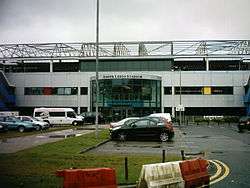Beeston, Leeds
| Beeston | |
 Town Street, Beeston |
|
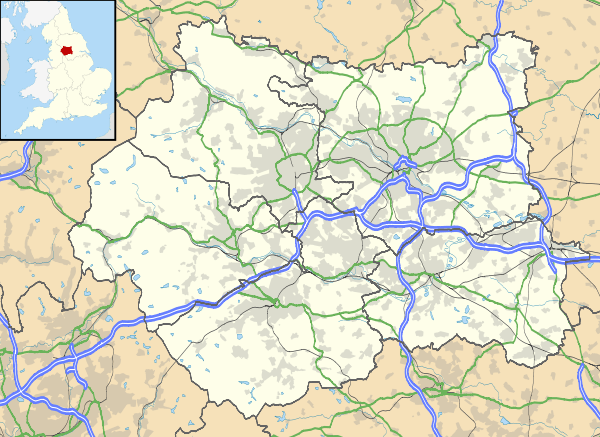 Beeston |
|
| Population | 15,302 (2011)[1] |
|---|---|
| OS grid reference | SE294313 |
| Metropolitan borough | City of Leeds |
| Metropolitan county | West Yorkshire |
| Region | Yorkshire and the Humber |
| Country | England |
| Sovereign state | United Kingdom |
| Post town | LEEDS |
| Postcode district | LS11 |
| Dialling code | 0113 |
| Police | West Yorkshire |
| Fire | West Yorkshire |
| Ambulance | Yorkshire |
| EU Parliament | Yorkshire and the Humber |
| UK Parliament | Leeds Central |
Coordinates: 53°46′34″N 1°33′21″W / 53.7761°N 1.5559°W
Beeston is a suburb of Leeds, West Yorkshire, England located about 2 miles (3 km) south-south west of the city centre. The area is separated from surrounding areas to the north, east and west by the M621 motorway.
The origins of Beeston can be traced back to the medieval period. It remained a small settlement until the latter part of the Victorian era when it became a primarily residential area for people working in Leeds and surrounding industrial areas like Holbeck and Hunslet. More recently, it gained notoriety as the home of two of the 7 July bombers.
Beeston has a population of about 20,000 people. At the time of the 2011 census Beeston had been included in the City and Hunslet Ward of Leeds City Council. Parts of the area, particularly around Beeston Hill to the north, suffer from relatively high levels of deprivation, while areas to the centre and south of the area suffer from fewer incidents of crime and are generally considered more affluent. Beeston is home to the Leeds United football club and Hunslet rugby league club.
History
Beeston is first mentioned in the 1086 Domesday Book as Bestone, when it had recently been granted to Ilbert de Lacy (1045–93); in 1066 it had been worth 40 shillings (£2), but in 1086 it was considered waste, presumably because of the Harrying of the North.[2] The name seems to come from Old English *bēos 'bent-grass' (L. Agrostis) and tūn 'estate, village',[3] and the origin of the settlement is likely to be Anglo-Saxon.[4] It was one of the ten 'out-townships' of the Parish of Leeds until the parish was broken up in the 1840s-50s.
In the medieval period, Beeston was associated with sheep-farming: the monks of Kirkstall Abbey grazed 240 sheep there. Founding Drax Priory in the 1130s, William Paynel granted it land in Beeston. A small hospital seems to have been founded in the township around 1233, and a chapel dedicated to St Mary the Virgin may also have been founded in the 13th century.[2]
The oldest buildings in Beeston today date to the 15th century. Cad Beeston (or Cad-Beeston, Cat Beeston, or Cat-Beeston) manor house has been dated by dendrochronology to about 1420, and is a grade II* listed building; recently used as private offices, it is now a private dwelling, with no public access.[5] Parts of Stank Hall Barn, a grade II* listed scheduled ancient monument originally built for the storage of crops, have been dated to between 1448 and 1490.[6][7]
'By the early 17th century the area had a reputation for manufacturing bone lace', and by the middle of the century, coal-mining was underway in the area.[2] According to David Thornton,
in December 1688 rumours abounded in the town that an army of Roman Catholics were ravaging the surrounding area. Ralph Thoresby recorded, 'Beeston is actually burnt, and only some escaped to bring the doleful tidings! The drums beat, the bells rang backward, the women shrieked, and some doleful consternation seized upon all persons ... (B)lessed be God! The terror disappeared, it being a false alarm, taken from some drunken people.'[2]
Between 1740 and 1820, the Leeds-Elland and Dewsbury-Leeds turnpike roads were built through Beeston; nationalised in the 1870s these roads remain as Elland Road and Dewsbury Road respectively. By 1822, Beeston had a population of 1,670.[8] Up until the 19th century, Beeston had been a small mining village situated on a hill overlooking Leeds. However, during the Industrial Revolution, land that had been occupied by open pits, as well as land formerly utilised for farming, was snapped up for high density residential development.[9] By 1872, Beeston is recorded as having a population of 2,547 with 537 houses, a railway station and a post office,[10] and 'by the end of the 19th century Beeston was predominantly a working class community living in back-to-backs'.[2] Beeston was a township and civil parish 1866-1904, then was absorbed into Holbeck civil parish before this was absorbed into Leeds in 1925.
On the night of 14 March and early hours of 15 March 1941, during the Second World War, Leeds received its worst night of German aerial bombing. Beeston had more bombs dropped on it than any other district of the city and although Flaxton Terrace was damaged during the night time air raid, escaped with the less damage than most other areas of Leeds with nearly all the other bombs landing on Cross Flatts Park. In his 2005 poem "Shrapnel", Tony Harrison, who was in Beeston on the night of the raid, speculates whether this was an act of heroism by the German pilot, a theory that has been explored ever since the raid.[11] Holbeck Cemetery, in Beeston, also features prominently in Harrison's 1985 poem "v".
Beeston was formerly home to card and board game manufacturer Waddingtons, though the factory was vacated in the 1990s and is now home to Nampak Cartons.
In 2006 the district was the setting for much of the film Mischief Night.
Geography and demographics

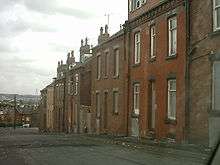
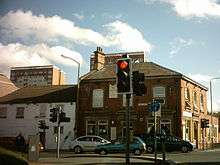
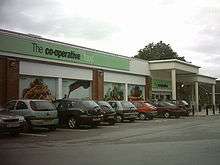
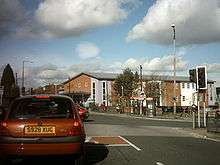
_Station_1779989_ae7d591c.jpg)

Beeston is an inner-city area located close to Leeds city centre. Beeston is severed from the areas to the north by the M621 motorway. Beeston is separated from Middleton by Middleton Park and from Cottingley by the Leeds Outer Ring Road.
Beeston can be described as three distinct areas. Beeston - Parkside and Cross Flatts area and Beeston Hill are separated by Cross Flatts Park which runs between Dewsbury Road and Town Street: Beeston Hill to the east, and Parkside and Cross Flatts to the west. The distinction between these two areas has probably existed since medieval times when they were two separate manors.[4] Beeston - Elland Road and Millshaw is primarily industrial and centred on Elland Road to the west of the area.
Beeston - Parkside and Cross Flatts area
The Parkside and Cross Flatts area of Beeston, sometimes locally known as Beeston Village, is centred on a shopping centre comprising a Co-operative store and a number of smaller shops. Housing in this part of Beeston is made up of almost equal proportions of late Victorian and early 20th Century terraced housing to the east of Old Lane, and newer semi-detached family and housing association properties to the west.[12] To the south side of Dewsbury Road, there are significant areas of industrial premises.
Indicators for health, economic activity and community safety in this area are broadly consistent with averages for the City of Leeds as a whole.[12]
Beeston Hill area
Beeston Hill is largely made up of areas of older Victoria terraces and newer social housing, which comprises around a third of the housing stock in the area.[13] In April 2008, a £93 million PFI scheme to build 700 private and housing association dwellings and regenerate some existing stock was announced.[14] As a particularly deprived area, Beeston Hill along with Holbeck was the beneficiary of Objective 2 European funding. Beeston Hill has a relatively high level of empty housing as well as a number of significant unoccupied commercial premises, such as the former Malvern public house. Beeston Hill has a significant ethnic minority population, with around 40% of the population from BME Communities.[13]
The area suffers from a high level of deprivation, with indicators for health, economic activity and community safety substantially worse than for the City of Leeds as a whole.[13]
Beeston - Elland Road and Millshaw Area
The west of Beeston around Elland Road has significant amounts of industrial estates, with a substantial amount of mainly semi-detached and terraced housing to the western edge of the Parkside and Cross Flatts area.
Transport
Beeston has a mainline railway line running along its Western edge along which all services between Leeds City railway station and London Kings Cross and London St Pancras run. However, there are no stations along it as Beeston station closed to passengers in 1953. Beeston is served by a number of bus services along Dewsbury Road, Elland Road and Town Street. The frequent No 1 bus service, operated by First Leeds largely follows the route of the former Leeds Tramway route 5 through Beeston and Beeston Hill. Beeston is severed from Leeds by the M621 and therefore benefits from very good links with the M621 motorway, as well as the M62, which runs close to Beeston to the south of Morley. There are a several taxi companies operating in the Beeston area, while there are proposals to create a park-and-ride site at Elland Road.[15]
Economy
Much of Beeston's traditional heavy industry and fabrication works have closed throughout the last forty years. However, there are substantial areas of industrial and commercial development around Elland Road and to the south of Dewsbury Road and Beeston is surrounded by areas which have become popular with businesses, such as Leeds city centre, Tingley and many of the business districts along the south side of the River Aire. The neighbouring White Rose Shopping Centre employs thousands of full- and part-time staff.
Education
Beeston is home to the Leeds College of Technology School of Mechanics situated towards the south side, the Beeston Centre of the Leeds City College (formerly Joseph Priestley College) and Elliott Hudson College. Beeston has one secondary school, Cockburn School which is a specialist arts college.[16] Matthew Murray High School situated between Beeston and Holbeck closed down in 2004 and was merged with Merlyn Rees High School in Belle Isle, to form South Leeds High School in Belle Isle. In September 2009 South Leeds High School was reopened as the South Leeds Academy.[17] There are seven primary schools in the area.
Local facilities and attractions
Beeston has a range of facilities. It has two large health centres, Elland Road stadium and the John Charles Centre for Sport. Leeds city centre is a short distance away and the M1 and M62 motorways are easily accessed. Cross Flatts Park has many facilities, which include 5-a-side football pitches, tennis courts, two separate play areas one for older children and one for younger children and a bowling green.
Stadia
Beeston is home to two stadiums. Elland Road, home of Leeds United AFC has a 39,640 capacity, all-seater stadium[18] on Elland Road, adjacent to the M621 in the north of Beeston. The South Leeds Stadium, part of the John Charles Centre for Sport is situated on Middleton Grove (off Dewsbury Road) on the southern edge of Beeston. This is home to Hunslet Hawks rugby league club, as well as hosting athletics and aquatic sports in the new Aquatic Centre (the replacement for the Leeds International Swimming Pool) which opened in October 2008 and provides an Olympic standard swimming pool and diving pool. The centre also has indoor bowling, indoor Tennis Centre, athletics stadium, rugby pitches and 5-a-side pitches.
Cross Flatts Park
Cross Flatts Park covers an area of 44 acres (17.8 hectares)[19] in the centre of Beeston. While the park formerly suffered from neglect and had a high crime rate, through the work of the Council and community groups such as Friends of Cross Flatts Park and Beeston in Bloom the park has been cleaned up and made safer and more welcoming.[20]
The park has a large multi-use games area which includes five-a-side football pitches, basketball courts and tennis courts, while the park boasts an artificial cricket pitch, a children's play area and outdoor gym equipment. The park is the venue for the Beeston Festival which takes place annually in June, and in summer and school holidays is host to numerous activities for young people. The park hosts a weekly 5 km Parkrun every Saturday morning at 9am, over 1,000 runners have taken part in the event since it began on 30 March 2013.
Holbeck Cemetery

Holbeck Cemetery in Beeston opened in 1857 and closed to general burials in the 1940s. During the period it was operational, thousands of people were buried there with many in 'guinea graves' with several unrelated people buried in the same plot. The graves were so called for the shared headstones on which a single-line inscription cost one guinea (21 shillings).
Henry Rowland Marsden, the Victorian industrialist and former mayor of Leeds, is buried in Holbeck Cemetery where his family grave is marked by a Grade II-listed memorial.[21]
The poem 'v.' by Tony Harrison, published in 1985, describes a visit to Holbeck Cemetery and his reaction to finding his parents' tombstones vandalised.
Greenhouse
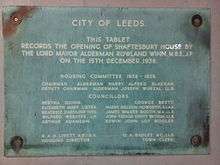
In 2008 Shaftesbury House, a working men's hostel designed for the council by George C. Robb in 1936, was converted by Citu to the Greenhouse, an eco-friendly housing project. The building had been empty for a number of years and had previously been earmarked for demolition.
The development, which includes 172 homes, office space and other facilities, is one of the UK's first low-carbon housing developments and incorporates wind turbines, solar panels and ground source heating as well as energy efficient materials and rainwater and grey water recycling. The development has won a large number of awards, including, in 2011, the Regeneration and Renewal Magazine Regeneration Award for Sustainability, with judges praising the holistic way it addressed sustainability and provides real regeneration benefits to a deprived area.[22]
Religious sites
_UK_Gurdwara-Former_Ringtons_Tea_Packing_Factory.jpg)
Beeston has at least ten churches of several denominations including Church of England, Roman Catholic, Methodist and Baptist. The Anglican churches of St Mary on Town Street and St Luke on Malvern Road were constructed in the 1870s, though the former is on the site of a much older church. The more modern church of St David Waincliffe on Dewsbury Road, constructed in the 1960s was designed by Geoffrey Davy[23] and won a Hoffman Wood (Leeds) Gold Medal for Architecture.[24]
There are three mosques in Beeston, all located within the Beeston Hill area. There is also a Sikh Gurdwara.
Government
Most parts of Beeston are located within the Beeston and Holbeck Ward of Leeds City Council. It is currently represented by three Labour councillors:
- Angela Gabriel (elected to serve until 2012),[25]
- David Congreve (elected to serve until 2014),[26] and
- Adam Ogilvie (elected 2011,[27] re-elected 2015 to serve to 2019)[28]
Parts of Beeston Hill to the north of Cross Flatts Park are located within the City and Holbeck Ward which is also currently represented by three Labour councillors:
- Elizabeth Nash (elected to serve until 2012),[29]
- Mohammed Iqbal (elected to serve until 2014),[30] and
- Patrick Davey (elected 2011,[31] re-elected 2015 to serve until 2019)[28]
Hilary Benn (Labour) has been MP since 1999 when he won the seat following the death of Derek Fatchett who had been MP for Leeds Central since 1983. Before the 1997 general election, Beeston was part of the Morley and Leeds South constituency, represented from its creation in 1983 to 1992 by Merlyn Rees and from 1992 to 1997 by John Gunnell. Before the creation of the Morley and South Leeds constituency the area was part of the Leeds South constituency represented until 1963 by Hugh Gaitskell, leader of the Labour Party from 1955 to his death in 1963, after whom a primary school in the area is named.[32][33]
Members of the European Parliament (MEPs) for Yorkshire and the Humber European Parliament constituency since the 2009 European election, are Godfrey Bloom (UK Independence Party), Andrew Brons (BNP), Timothy Kirkhope (Conservative), Linda McAvan (Labour), Edward McMillan-Scott (Liberal Democrat), and Diana Wallis (Liberal Democrat).[34]
Notable people
The playwright Willis Hall attended Cockburn High School in Beeston[35] as did the academic and author of The Uses of Literacy, Richard Hoggart.[36] The poet Tony Harrison was brought up on Tempest Road and went to what was then Cross Flatts county primary school.[37] More recently, the actress Holly Kenny who starred in the BBC drama serial Waterloo Road was a pupil at the school.
The musician and bandleader Ivy Benson grew up in Beeston, where her former house on Cemetery Road is marked with a blue plaque.[38]
Former England and Leeds United footballer Paul Madeley was born in Beeston.
Former international rugby league and rugby union star Jason Robinson went to Cross Flatts Park Middle School and Matthew Murray High School, and began his Rugby League career with Hunslet Hawks.[39]
Leigh Francis, famous for his character Keith Lemon, was born in Beeston.
London bombings
Beeston was the focus of press attention following 7 July 2005 London bombings when it was revealed that two of the four bombers had lived in the area. On 12 July, two properties in Beeston were raided by police in connection with the attacks.[40] According to West Yorkshire Police, a significant amount of explosive material was found in the raids and a controlled explosion was carried out at one of the properties.
After-effects
The link between 7 July bombings and Beeston became known several days after the event took place. When news began to emerge of the Beeston link to the attacks, community and religious groups from across Beeston came together to condemn the atrocities,.[41] There was a significant pulling together of people across the community with two Beeston Together for Peace marches being held. Each were joined by hundreds of people, some as the procession passed. The second procession ended at Millennium Square in Leeds city centre, uniting with people from other parts of Leeds for an interfaith vigil.[42]
Beeston in the press
Following the London press, Beeston was thrust into the local, regional, national and international press, with journalists from as far away as North America and Japan arriving in the area to cover the reaction to the events of the previous week.[43] The tone of the reporting was mixed, some sympathetic to the area, many even describing Beeston as a 'leafy suburb', whereas others painted a less salubrious picture of Beeston.
The Guardian
Writing a year after the bombings, a journalist from The Guardian visited Beeston with the aim of going "beyond the stereotypical pictures of veiled women and bearded men strolling past dilapidated buildings." The article reported that the community in Beeston had on the whole condemned the attacks.[44]
NBC
American news network NBC described Beeston as "a drab and derelict neighbourhood in Leeds, three hours north of London, where three of the four London suicide bombers were born and raised". The article later stated, "Beeston, a poor racially mixed community, is lined with small row houses built in another era to house the factory workers who were one of the cornerstones of the British industry. The neighbourhood has long accommodated immigrant communities — from Asia in the 1960s to Eastern Europe and Africa today. Reportedly, almost half the households now are on some sort of state assistance."[45]
Los Angeles Times
The Los Angeles Times described Beeston as an "ethnically mixed, downtrodden suburb". Setting the scene, it also said "Peeping from lacy curtains in red-brick rowhouses, tattoed white men, turbaned Sikhs and olive-skinned women in gauzy headscarves shared what they knew."[46]
International Herald Tribune
One year after the London Bombings, the International Herald Tribune described Beeston as a "grim northern neighbourhood". The paper also said "It is a poor and racially mixed neighbourhood of back-to-back row houses with a population of just a few thousand where successive waves of immigrants from Asia in the 1960s, and now from East Europe and Africa, have spread a tangled overlay on a cityscape forged in Victorian Britain. The bright pink and turquoise saris of Asian women offer chromatic relief from drab brick homes".[47]
Socialist Worker
The Socialist Worker focused on Beeston's positive aspect and reported on the 'Beeston United for Peace' vigil, organised by Beeston members of the Stop the War Coalition. The 150 strong march from Hyde Park was also covered.[48]
Location grid
 |
Wortley | Holbeck | Hunslet |  |
| New Farnley, Gildersome | |
Belle Isle | ||
| ||||
| | ||||
| Churwell, Morley | Tingley | Middleton |
References
- ↑ Beeston is made up of 50 Output areas in the Beeston and Holbeck ward http://ukcensusdata.com/beeston-and-holbeck-e05001415#sthash.hDobmYL0.OLeNWOC4.dpbs
- 1 2 3 4 5 David Thornton, Leeds: A Historical Dictionary of People, Places and Events (Huddersfield: Northern Heritage Publications, 2013), s.v. BEESTON.
- ↑ A. H. Smith, The Place-Names of the West Riding of Yorkshire, English Place-Names Society, 30–37, 8 vols (Cambridge: Cambridge University Press, 1961–63), III 217; cf. The Vocabulary of English Place-Names (Á-BOX), ed. by David Parsons and Tania Styles with Carole Hough (Nottingham: Centre for Name Studies, 1997), s.v. *bēos.
- 1 2 "Beeston History". Yorkshire Evening Post. Retrieved 24 August 2011.
- ↑ Historic England. "The Manor House Cad Beeston (1255940)". National Heritage List for England. Retrieved 14 October 2011.
- ↑ Historic England. "Stank Hall Barn (1375339)". National Heritage List for England. Retrieved 14 October 2011.
- ↑ "Ancient Monuments". Leeds City Council. Archived from the original on 27 December 2011. Retrieved 14 October 2011.
- ↑ "In 1822, the following places were in the Parish of Leeds:". GENUKI. Retrieved 18 October 2011.
- ↑ A vision of Britain through time. "Relationships / unit history of BEESTON". Archived from the original on 5 June 2011. Retrieved 5 November 2007.
- ↑ "History of Britain, in Leeds and Yorkshire". A vision of Britain through time. Retrieved 18 October 2011.
- ↑ "Bombs over Beeston". BBC Leeds. 12 December 2008. Retrieved 17 October 2011.
- 1 2 "Beeston - Parkside and Cross Flatts" (PDF). Leeds Neighbourhood Index. Leeds City Council. Retrieved 17 October 2011.
- 1 2 3 "Beeston Hill" (PDF). Leeds Neighbourhood Index. Leeds City Council. Archived from the original (PDF) on 4 March 2016. Retrieved 17 October 2011.
- ↑ "At long last Leeds is in the money". Yorkshire Evening Post. 3 April 2008. Retrieved 27 May 2008.
- ↑ Development of a Bid to the Local Transport Fund May 2011
- ↑ Cockburn School website
- ↑ Green light for new city academy
- ↑ Leeds United Club Records
- ↑ Cross Flatts Park
- ↑ Cross Flatts Park, Beeston
- ↑ Historic England. "Holbeck Cemetery Memorial to Henry Marsden approximately 20 metres west of Lodge (1375436)". National Heritage List for England. Retrieved 14 October 2011.
- ↑ "Regeneration Awards 2011". Planning Magazine. London. 7 October 2011.
- ↑ Minnis, John. "A survey and gazetteer of places of worship 1900-2005" (PDF). Religion in Leeds. English Heritage. Retrieved 18 October 2011.
- ↑ "St David's Waincliffe". Beeston Team Ministry. Archived from the original on 21 November 2013. Retrieved 18 October 2011.
- ↑ "Council and democracy - Angela Gabriel". Leeds City Council. Retrieved 17 October 2011.
- ↑ "Council and democracy - David Congreve". Leeds City Council. Retrieved 17 October 2011.
- ↑ "Council and democracy - Adam Ogilvie". Leeds City Council. Retrieved 17 October 2011.
- 1 2 Jeremy Morton, '2015 South Leeds Council election results', South Leeds Life, 8 May 2015; www.southleedslife.com/2015-south-leeds-council-election-results/.
- ↑ "Council and democracy - Elizabeth Nash". Leeds City Council. Retrieved 17 October 2011.
- ↑ "Council and democracy - Mohammed Iqbal". Leeds City Council. Retrieved 17 October 2011.
- ↑ "Council and democracy - Patrick Davey". Leeds City Council. Retrieved 17 October 2011.
- ↑ Rayment, Leigh. "The House of Commons Constituencies beginning with "L"". Leigh Rayment. Retrieved 17 October 2011.
- ↑ Rayment, Leigh. "The House of Commons Constituencies beginning with "L"". Leigh Rayment. Retrieved 17 October 2011.
- ↑ "Your MEPs Members of the European Parliament MEPs". Leeds City Council. Retrieved 17 October 2011.
- ↑ Barker, Dennis (12 March 2005). "Obituary: Willis Hall". The Guardian. Retrieved 17 October 2011.
- ↑ Wroe, Nicholas (7 February 2004). "Profile: Richard Hoggart". The Guardian. Retrieved 18 October 2011.
- ↑ 'Bombs over Beeston', 12 December 2008; http://www.bbc.co.uk/leeds/content/articles/2008/12/12/local_history_beeston_bombing_feature.shtml.
- ↑ "Bandleader Ivy Benson gets Leeds blue plaque". BBC News. 5 July 2011. Retrieved 17 October 2011.
- ↑ Davies, Gareth A (23 April 2001). "My School Sport: Jason Robinson". The Daily Telegraph. Retrieved 18 October 2011.
- ↑ "Shock in the Morning". Yorkshire Evening Post. 12 July 2005. Retrieved 17 October 2011.
- ↑ Rosser, Ian (12 July 2005). "Call for calm as religious and community leaders show unity". Yorkshire Evening Post. Retrieved 17 October 2011.
- ↑ "Residents join in march for peace". BBC News. 23 July 2005. Retrieved 17 October 2011.
- ↑ Ward, David (21 July 2005). "The Paradox of Beeston". The Guardian. Retrieved 17 October 2011.
- ↑ Martino, Eduardo (6 July 2006). "Behind Beeston's stereotypes". The Guardian. London. Retrieved 26 April 2010.
- ↑ http://www.msnbc.msn.com/id/13720432/
- ↑ http://www.calendarlive.com/movies/video/ny-woside154344002jul15,2,7644680.story
- ↑ http://www.iht.com/articles/2006/07/04/news/britain.php
- ↑ http://www.socialistworker.co.uk/art.php?id=6979
External links
- YEP Beeston Today Community Website
- Historic England. "Manor House, Cad Beeston; grade II* listed (465423)". Images of England.
- Historic England. "Cad Beeston; grade II listed (465422)". Images of England.
- The ancient parish of Leeds: historical and genealogical information at GENUKI (Beeston was in this parish).
